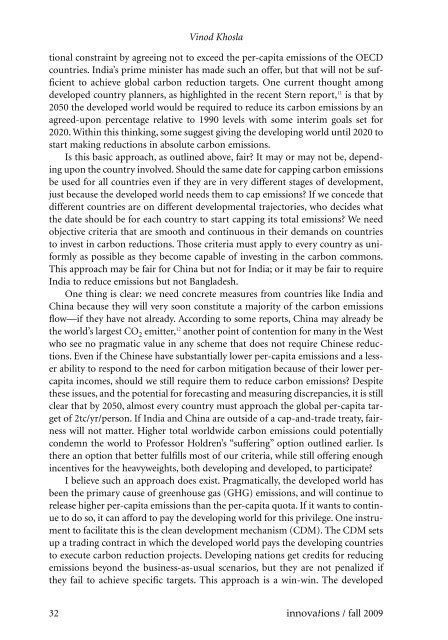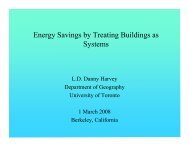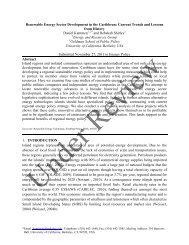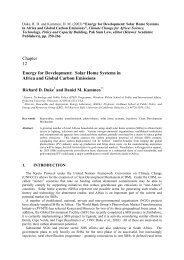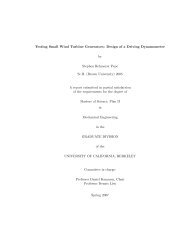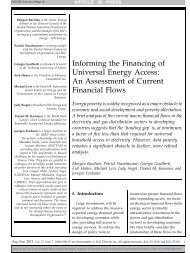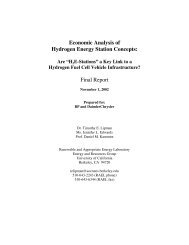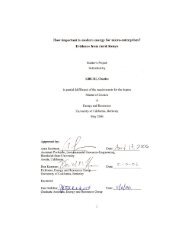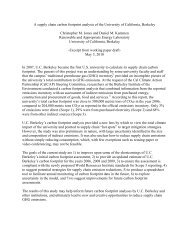Innovations, Energy for Change, Fall 2009.pdf - Renewable and ...
Innovations, Energy for Change, Fall 2009.pdf - Renewable and ...
Innovations, Energy for Change, Fall 2009.pdf - Renewable and ...
You also want an ePaper? Increase the reach of your titles
YUMPU automatically turns print PDFs into web optimized ePapers that Google loves.
Vinod Khosla<br />
tional constraint by agreeing not to exceed the per-capita emissions of the OECD<br />
countries. India’s prime minister has made such an offer, but that will not be sufficient<br />
to achieve global carbon reduction targets. One current thought among<br />
developed country planners, as highlighted in the recent Stern report, 11 is that by<br />
2050 the developed world would be required to reduce its carbon emissions by an<br />
agreed-upon percentage relative to 1990 levels with some interim goals set <strong>for</strong><br />
2020. Within this thinking, some suggest giving the developing world until 2020 to<br />
start making reductions in absolute carbon emissions.<br />
Is this basic approach, as outlined above, fair? It may or may not be, depending<br />
upon the country involved. Should the same date <strong>for</strong> capping carbon emissions<br />
be used <strong>for</strong> all countries even if they are in very different stages of development,<br />
just because the developed world needs them to cap emissions? If we concede that<br />
different countries are on different developmental trajectories, who decides what<br />
the date should be <strong>for</strong> each country to start capping its total emissions? We need<br />
objective criteria that are smooth <strong>and</strong> continuous in their dem<strong>and</strong>s on countries<br />
to invest in carbon reductions. Those criteria must apply to every country as uni<strong>for</strong>mly<br />
as possible as they become capable of investing in the carbon commons.<br />
This approach may be fair <strong>for</strong> China but not <strong>for</strong> India; or it may be fair to require<br />
India to reduce emissions but not Bangladesh.<br />
One thing is clear: we need concrete measures from countries like India <strong>and</strong><br />
China because they will very soon constitute a majority of the carbon emissions<br />
flow—if they have not already. According to some reports, China may already be<br />
the world’s largest CO 2 emitter, 12 another point of contention <strong>for</strong> many in the West<br />
who see no pragmatic value in any scheme that does not require Chinese reductions.<br />
Even if the Chinese have substantially lower per-capita emissions <strong>and</strong> a lesser<br />
ability to respond to the need <strong>for</strong> carbon mitigation because of their lower percapita<br />
incomes, should we still require them to reduce carbon emissions? Despite<br />
these issues, <strong>and</strong> the potential <strong>for</strong> <strong>for</strong>ecasting <strong>and</strong> measuring discrepancies, it is still<br />
clear that by 2050, almost every country must approach the global per-capita target<br />
of 2tc/yr/person. If India <strong>and</strong> China are outside of a cap-<strong>and</strong>-trade treaty, fairness<br />
will not matter. Higher total worldwide carbon emissions could potentially<br />
condemn the world to Professor Holdren’s “suffering” option outlined earlier. Is<br />
there an option that better fulfills most of our criteria, while still offering enough<br />
incentives <strong>for</strong> the heavyweights, both developing <strong>and</strong> developed, to participate?<br />
I believe such an approach does exist. Pragmatically, the developed world has<br />
been the primary cause of greenhouse gas (GHG) emissions, <strong>and</strong> will continue to<br />
release higher per-capita emissions than the per-capita quota. If it wants to continue<br />
to do so, it can af<strong>for</strong>d to pay the developing world <strong>for</strong> this privilege. One instrument<br />
to facilitate this is the clean development mechanism (CDM). The CDM sets<br />
up a trading contract in which the developed world pays the developing countries<br />
to execute carbon reduction projects. Developing nations get credits <strong>for</strong> reducing<br />
emissions beyond the business-as-usual scenarios, but they are not penalized if<br />
they fail to achieve specific targets. This approach is a win-win. The developed<br />
32 innovations / fall 2009


